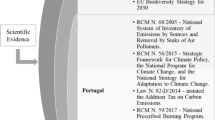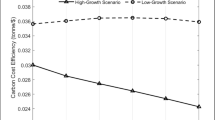Abstract
Spatial consideration of costs and benefits plays a critical role in assessing the effectiveness of payments for ecosystem services (PES). While spatial assessment has received much attention, few, if any, studies have explicitly considered spatial variations in the benefits and landowners’ opportunity costs of competing land uses as targeting criteria for PES. The objective of our research is to identify different spatial targets for PES based on spatial variations in ecosystem benefits and opportunity costs for competing land uses. As a case study, we use incentive payments for forest carbon storage in the Central and Southern Appalachian Regions of the eastern United States. We find, on average, supplying forest carbon storage by converting pasture to forest is approximately five times more cost effective than mitigating deforestation for urban use because of its lower opportunity cost and its higher per hectare gain in carbon storage. We also find that the targeted areas that have positive net social benefits in supplying forest carbon represent 9.32% of the case-study region’s pasture land, while zero pixels are identified with positive net social benefits when urban use is the competing land use. These findings imply that the spatial targeting of the region’s areas that have positive net social benefits should focus on afforesting pasture instead of preventing forestland from being converted to urban use. The results also help target cost-effective areas for afforestation of pasture for carbon storage.



Similar content being viewed by others
Notes
The authors appreciate an anonymous referee for bringing this issue to our attention.
References
Abolina E, Luzadis VA (2013) Forest sustainability and social policy: the role of ecosystem services. In: Wallimann I (ed) Environmental policy is social policy–social policy is environmental policy. Springer, New York, pp 63–78
Ando A, Camm J, Polasky S, Solow A (1998) Species distributions, land values, and efficient conservation. Science 279:2126–2128. https://doi.org/10.1126/science.279.5359.2126
Armsworth PR, Acs S, Dallimer M, Gaston KJ, Hanley N, Wilson P (2012) The cost of policy simplification in conservation incentive programs. Ecol Lett 15:406–414. https://doi.org/10.1111/j.1461-0248.2012.01747.x
Babcock BA, Lakshminarayan PG, Wu J, Zilberman D (1996) The economics of a public fund for environmental amenities: a study of CRP contracts. Am J Agric Econ 78:961–971. https://doi.org/10.2307/1243852
Babcock BA, Lakshminarayan PG, Wu J, Zilberman D (1997) Targeting tools for the purchase of environmental amenities. Land Econ 73:325–339. https://doi.org/10.2307/3147171
Barton DN, Faith D, Rusch G, Gjershaug JO, Castro M, Vega M, Vega E (2003) Spatial prioritisation of environmental service payments for biodiversity protection. NIVA (Norwegian Institute for Water Research). Norway
Cho S, Lee J, Roberts RK, English BC, Yu ET, Kim T, Armsworth PR (2017) Evaluating a tax-based subsidy approach for forest carbon sequestration. Environ Conserv 44:244–243. https://doi.org/10.1017/S0376892917000078
Claassen R, Cattaneo A, Johansson R (2008) Cost-effective design of agri-environmental payment programs: U.S. experience in theory and practice. Ecol Econ 65:737–752. https://doi.org/10.1016/j.ecolecon.2007.07.032
Crossman ND, Connor JD, Bryan BA, Summers DM, Ginnivan J (2010) Reconfiguring an irrigation landscape to improve provision of ecosystem services. Ecol Econ 69:1031–1042. https://doi.org/10.1016/j.ecolecon.2009.11.020
Engel S, Pagiola S, Wunder S (2008) Designing payments for environmental services in theory and practice: an overview of the issues. Ecol Econ 65:663–674. https://doi.org/10.1016/j.ecolecon.2008.03.011
ESRI (2012) ArcGIS help 10.1: Spatial analyst toolsets, ArcGIS resources. http://www.esri.com/. Accessed 30 Jan 2018
Faustmann M (1849) Calculation of the value which forest land and immature stands possess for forestry. In: Gane M (ed) Martin Faustmann and the evolution of discounted cash flow: two articles from the original German of 1849. Commonwealth Forestry Institute, Oxford, pp 18–34
Ferraro PJ (2004) Targeting conservation investments in heterogeneous landscapes — a distance function approach and application to watershed management. Am J Agric Econ 86:905–918. https://doi.org/10.1111/j.0002-9092.2004.00642.x
Foldvary EF (1997) The business cycle: a geo-Austrian synthesis. Am J Econ Sociol 56:521–541. https://doi.org/10.1126/science.1078104
Goldman-Benner RL, Benitez S, Boucher T, Calvache A, Daily G, Kareiva P, Kroeger T, Ramos A (2012) Water funds and payments for ecosystem services: practice learns from theory and theory can learn from practice. Oryx 46:55–63. https://doi.org/10.1017/S0030605311001050
Hayes DJ, McGuire AD, Kicklighter DW, Gurney KR, Burnside TJ, Melillo JM (2011) Is the northern high-latitude land-based CO2 sink weakening? Glob Biogeochem Cycles 25. https://doi.org/10.1029/2010GB003813
Hellerstein D, Higgins N (2010) The effective use of limited information: do bid maximums reduce procurement cost in asymmetric auctions? J Agric Resour Econ 39:288–304. https://doi.org/10.1017/S1068280500007309
Hoyt H (1933) One hundred years of land values in Chicago. Rpt Amo Press & The New York Times, 1970, New York
Hoyt H (2000) One hundred years of land values in Chicago: The Relationship of the Growth of Chicago to the Rise of Its Land Values, 1830-1933. Rpt Amo Press & The New York Times, 1970, New York
Hsiao C (2014) Analysis of panel data. Cambridge University Press, Cambridge
Huang H-H (2016) Three essays on applied environmental economics. Dissertation, University of Michigan
IDEAS (2018) XTABOND2: stata module to extend xtabond dynamic panel data estimator. https://ideas.repec.org/c/boc/bocode/s435901.html. Accessed 30 Jan 2018
Marine Biology Laboratory (2018) Terrestrial Ecosystem Model (TEM). http://ecosystems.mbl.edu/TEM/. Accessed 30 Jan 2018
Mason C, Plantinga A (2011) Contracting for impure public goods: carbon offsets and additionality. NBER Working Paper No. 16963. https://doi.org/10.3386/w16963
Multi-Resolution Land Characteristics Consortium (MRLC) (2011) National land cover database 2011 (NLCD2011). https://www.mrlc.gov/finddata.php. Accessed 30 Jan 2018
Myronidis D, Arabatzis G (2009) Evaluation of Greek post-fire erosion mitigation policy through spatial analysis. Pol J Environ Stud 18:865–872
National Agricultural Statistics Service (NASS) (2014) Quick stats. http://quickstats.nass.usda.gov/. Accessed 30 Jan 2018
National Sustainable Agriculture Coalition (2018) Conservation reserve program. http://sustainableagriculture.net/publications/grassrootsguide/conservation-environment/conservation-reserve-program/. Accessed 30 Jan 2018
Newburn D, Reed S, Berck P, Merenlender A (2005) Economics and land-use change in prioritizing private land conservation. Conserv Biol 19:1411–1420. https://doi.org/10.1111/j.1523-1739.2005.00199.x
Polasky S, Camm JD, Garber-Yonts B (2001) Selecting biological reserves cost-effectively: an application to terrestrial vertebrate conservation in Oregon. Land Econ 77:68–78. https://doi.org/10.2307/3146981
Porras I, Greig-Gran M, Neves N (2008) All that glitters: a review of payments for watershed services in developing countries. International Institute for Environment and Development, UK
Roodman D (2009) How to do xtabond2: an introduction to difference and system GMM in stata. Stata J 9:86–136
Schomers S, Matzdorf B (2013) Payments for ecosystem services: a review and comparison of developing and industrialized countries. Ecosyst Serv 6:16–30. https://doi.org/10.1016/j.ecoser.2013.01.002
Schomers S, Sattler C, Matzdorf B (2015) An analytical framework for assessing the potential of intermediaries to improve the performance of payments for ecosystem services. Land Use Policy 42:58–70. https://doi.org/10.1016/j.landusepol.2014.06.025
Sommerville MM, Jones JPG, Milner-Gulland EJ (2009) A revised conceptual framework for payments for environmental services. Ecol Soc 14:34. https://doi.org/10.5751/ES-03064-140234
Timber Mart-South (TMS) (2011) Product and services. http://www.timbermart-south.com.products.html. Accessed 30 Jan 2018
U.S. Census Bureau (2000) Census 2000 gateway. https://www.census.gov/main/www/cen2000.html. Accessed 30 January 2018
U.S. Census Bureau (2009) American community survey (ACS) 2009. https://www.census.gov/programs-surveys/acs/. Accessed 30 Jan 2018
U.S. Census Bureau (2010) American community survey (ACS) 2010. https://www.census.gov/programs-surveys/acs/. Accessed 30 Jan 2018
U.S. Census Bureau (2012) American community survey (ACS) 2012.https://www.census.gov/acs/www/data/data-tables-and-tools/data-profiles/2015/. Accessed 30 Jan 2018
U.S. Department of Agriculture Forest Service (2017) FIA data and tools. https://www.fia.fs.fed.us/tools-data/index.php. Accessed 30 Jan 2018
U.S. Geological Survey (2013) Protected Areas Data. http://gapanalysis.usgs.gov/padus/data/. Accessed 30 Jan 2018
U.S. Geological Survey, Gap Analysis Program (GAP) (2016) Protected areas database of the United States (PAD-US), version 1.4. Combined feature class
U.S. Interagency Working Group on Social Cost of Greenhouse Gases (2016) Technical support document: technical update of the social cost of carbon for regulatory impact analysis under executive order. In: Keck JM (ed) Social cost of carbon estimates for regulatory impact analysis: development and technical assessment. U.S. Government, Washington D.C, p 12866
Upadhyay TP, Solberg B, Sankhayan PL (2006) Use of models to analyse land-use changes, forest/soil degradation and carbon sequestration with special reference to Himalayan region: a review and analysis. For Policy Econ 9:349–371. https://doi.org/10.1016/j.forpol.2005.10.003
Uthes S, Matzdorf B, Müller K, Kaechele H (2010) Spatial targeting of agri-environmental measures: cost-effectiveness and distributional consequences. Environ Manag 46:494–509. https://doi.org/10.1007/s00267-010-9518-y
van der Horst D (2006) Spatial cost–benefit thinking in multi-functional forestry; towards a framework for spatial targeting of policy interventions. Ecol Econ 59:171–180. https://doi.org/10.1016/j.ecolecon.2005.10.005
Wendland KJ, Honzák M, Portela R, Vitale B, Rubinoff S, Randrianarisoa J (2010) Targeting and implementing payments for ecosystem services: opportunities for bundling biodiversity conservation with carbon and water services in Madagascar. Ecol Econ 69:2093–2107. https://doi.org/10.1016/j.ecolecon.2009.01.002
Windmeijer F (2005) A finite sample correction for the variance of linear efficient two-step GMM estimators. J Econom 126:25–51. https://doi.org/10.1016/j.jeconom.2004.02.005
Wunder S (2005) Payments for environmental services: some nuts and bolts. Center for International Forestry Research. https://www.cifor.org/publications/pdf_files/OccPapers/OP-42.pdf. Accessed 30 Jan 2018
Wunder S (2007) The efficiency of payments for environmental services in tropical conservation. Conserv Biol 21:48–58. https://doi.org/10.1111/j.1523-1739.2006.00559.x
Wunder S, Wertz-Kanounnikoff S (2009) Payments for ecosystem services: a new way of conserving biodiversity in forests. J Sustain For 28:576–596. https://doi.org/10.1080/10549810902905669
Wünscher T, Engel S, Wunder S (2008) Spatial targeting of payments for environmental services: a tool for boosting conservation benefits. Ecol Econ 65:822–833. https://doi.org/10.1016/j.ecolecon.2007.11.014
Acknowledgements
We gratefully acknowledge the Agriculture and Food Research Initiative Competitive Grant no. 11401442 and Multistate Project no. TEN00507 (Multistate no. W4133) from the USDA National Institute of Food and Agriculture through the project “Developing a Cost-Effective Payment System for Forest Carbon Sequestration” and “Costs and Benefits of Natural Resources on Public and Private Lands: Management, Economic, Valuation, and Integrated Decision-Making” respectively. We also gratefully acknowledge D.J. Hayes and G. Chen for generating carbon outputs and B. Wilson, J. Menard, L. Lambert, T. Kim, S. Kwon, and S. Moon for helpful discussion and data support.
Author information
Authors and Affiliations
Corresponding author
Additional information
Editor: Nicolas Dendoncker.
Rights and permissions
About this article
Cite this article
Kim, Y., Cho, SH. How spatial targeting of incentive payments for forest carbon storage can be adjusted for competing land uses. Reg Environ Change 19, 441–450 (2019). https://doi.org/10.1007/s10113-018-1411-x
Received:
Accepted:
Published:
Issue Date:
DOI: https://doi.org/10.1007/s10113-018-1411-x




